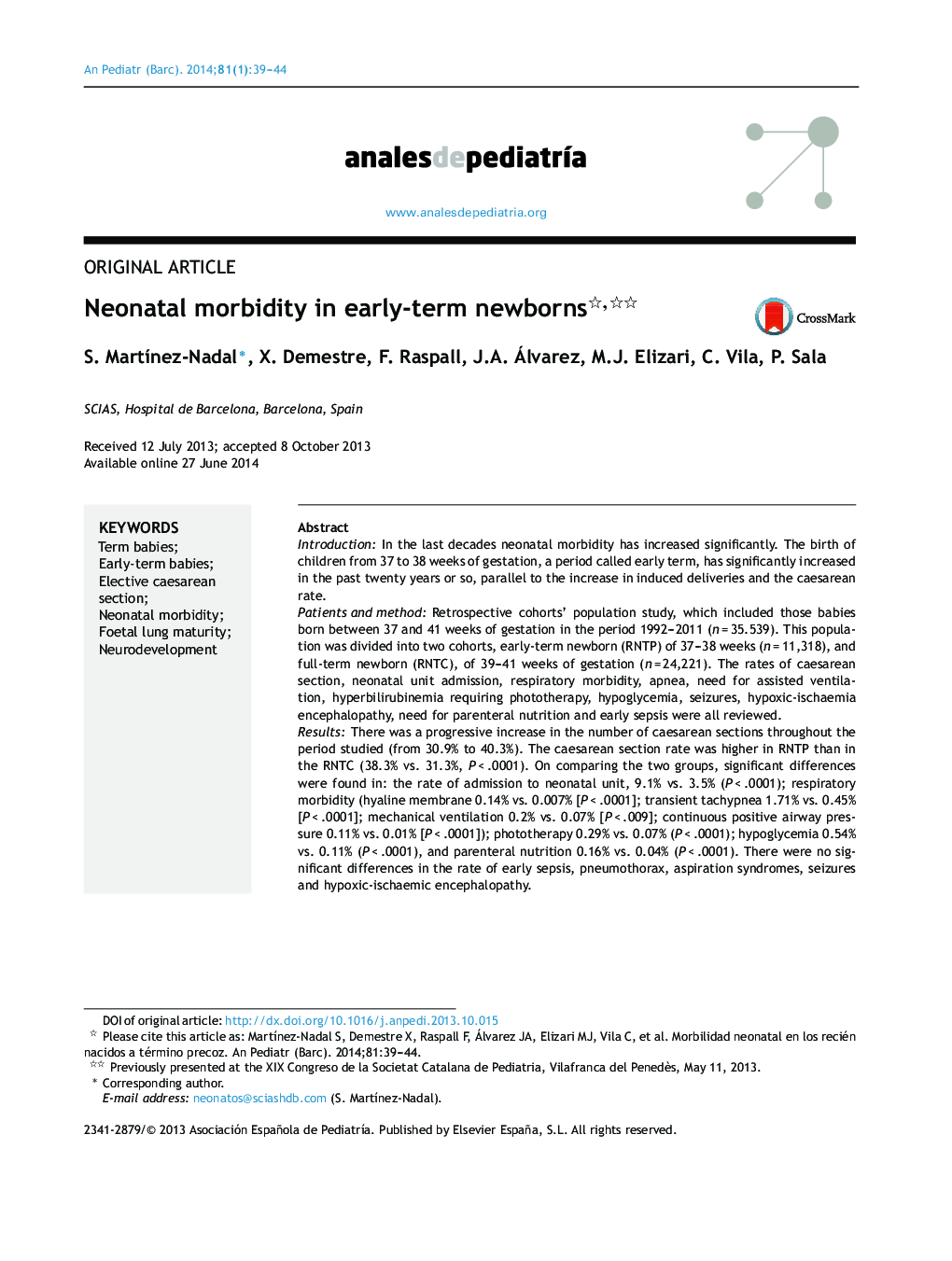| کد مقاله | کد نشریه | سال انتشار | مقاله انگلیسی | نسخه تمام متن |
|---|---|---|---|---|
| 4145317 | 1272602 | 2014 | 6 صفحه PDF | دانلود رایگان |
IntroductionIn the last decades neonatal morbidity has increased significantly. The birth of children from 37 to 38 weeks of gestation, a period called early term, has significantly increased in the past twenty years or so, parallel to the increase in induced deliveries and the caesarean rate.Patients and methodRetrospective cohorts’ population study, which included those babies born between 37 and 41 weeks of gestation in the period 1992–2011 (n = 35.539). This population was divided into two cohorts, early-term newborn (RNTP) of 37–38 weeks (n = 11,318), and full-term newborn (RNTC), of 39–41 weeks of gestation (n = 24,221). The rates of caesarean section, neonatal unit admission, respiratory morbidity, apnea, need for assisted ventilation, hyperbilirubinemia requiring phototherapy, hypoglycemia, seizures, hypoxic-ischaemia encephalopathy, need for parenteral nutrition and early sepsis were all reviewed.ResultsThere was a progressive increase in the number of caesarean sections throughout the period studied (from 30.9% to 40.3%). The caesarean section rate was higher in RNTP than in the RNTC (38.3% vs. 31.3%, P < .0001). On comparing the two groups, significant differences were found in: the rate of admission to neonatal unit, 9.1% vs. 3.5% (P < .0001); respiratory morbidity (hyaline membrane 0.14% vs. 0.007% [P < .0001]; transient tachypnea 1.71% vs. 0.45% [P < .0001]; mechanical ventilation 0.2% vs. 0.07% [P < .009]; continuous positive airway pressure 0.11% vs. 0.01% [P < .0001]); phototherapy 0.29% vs. 0.07% (P < .0001); hypoglycemia 0.54% vs. 0.11% (P < .0001), and parenteral nutrition 0.16% vs. 0.04% (P < .0001). There were no significant differences in the rate of early sepsis, pneumothorax, aspiration syndromes, seizures and hypoxic-ischaemic encephalopathy.ConclusionsIn our environment there is a significant number of RNTP, which have a significantly higher morbidity than newborns RNTC registered. After individualising each case, it is essential not to end a pregnancy before 39 weeks of gestation, except for maternal, placental or foetal conditions indicating that continuing the pregnancy may increase the risk for the foetus and/or the mother.
ResumenIntroducciónEn las últimas décadas ha aumentado de forma significativa el nacimiento de niños de 37 y 38 semanas de gestación, período denominado a término precoz, paralelamente al aumento de partos inducidos y el incremento en la tasa de cesáreas.Pacientes y métodoEstudio retrospectivo poblacional de cohortes, en el que se incluyó a los nacidos entre las 37 y 41 semanas de gestación en el período 1992-2011 (n = 35.539). Esta población se dividió en 2 cohortes, los recién nacidos a término precoz (RNTP), de 37-38 semanas (n = 11.318), y los recién nacidos a término completo (RNTC), de 39-41 semanas (n = 24.221). Se analizan la tasa de cesárea, el ingreso en unidad neonatal, la morbilidad respiratoria, la apnea y la necesidad de asistencia respiratoria, hiperbilirrubinemia que requiere fototerapia, hipoglucemia, convulsiones, encefalopatía hipóxico-isquémica, necesidad de nutrición parenteral y sepsis precoz.ResultadosSe observa un aumento progresivo del número de cesáreas a lo largo del período estudiado (del 30,9% al 40,3%). En los RNTP la tasa de cesárea fue superior que en los RNTC (38,3% vs. 31,3%; p < 0,0001). En la comparación de ambos grupos, se encontraron diferencias significativas en la tasa de ingreso en unidad neonatal, 9,1% vs. 3,5% (p < 0,0001); la morbilidad respiratoria (membrana hialina 0,14% vs. 0,007%; [p < 0,0001]); la taquipnea transitoria, 1,71% vs. 0,45% (p < 0,0001), la ventilación mecánica, 0,2% vs. 0,07% (p < 0,009); la presión positiva continua en la vía respiratoria, 0,11% vs. 0,01% (p < 0,0001); la fototerapia, 0,29% vs. 0,07% (p < 0,0001); la hipoglucemia, 0,54% vs. 0,11% (p < 0,0001), y la nutrición parenteral, 0,16% vs. 0,04% (p < 0,0001). No se encontraron diferencias significativas en la tasa de sepsis precoz, neumotórax, síndromes aspirativos, convulsiones y encefalopatía hipóxico-isquémica.ConclusionesEn nuestro medio, existe un número importante de RNTP, que presentan una morbilidad significativamente superior a los recién nacidos catalogados de RNTC. Tras individualizar cada caso, es aconsejable no finalizar un embarazo antes de las 39 semanas de gestación, salvo por condicionamientos maternos, placentarios o fetales que indiquen que continuar el embarazo comporte un mayor riesgo para el feto y/o la madre.
Journal: Anales de Pediatría (English Edition) - Volume 81, Issue 1, July 2014, Pages 39–44
